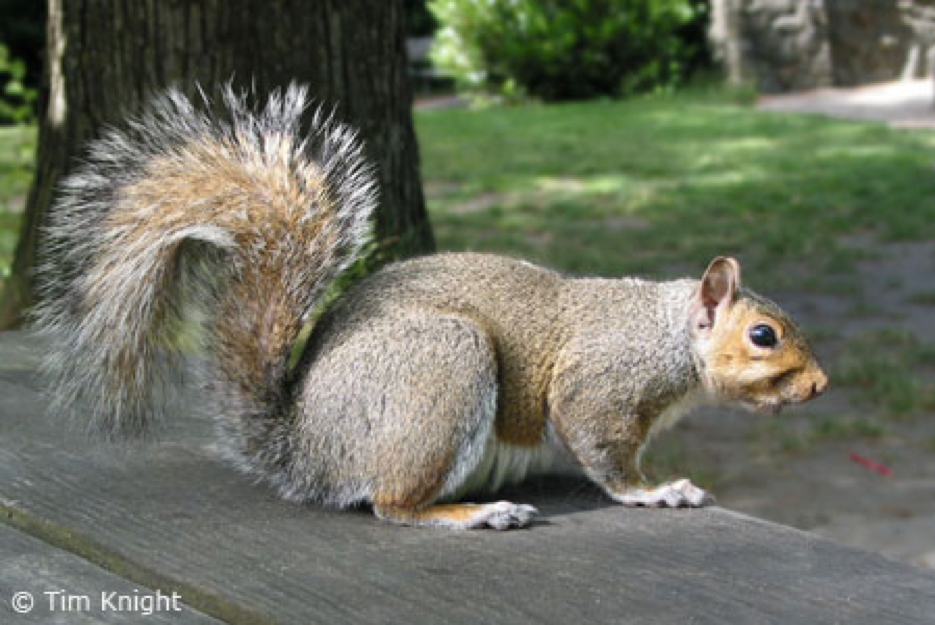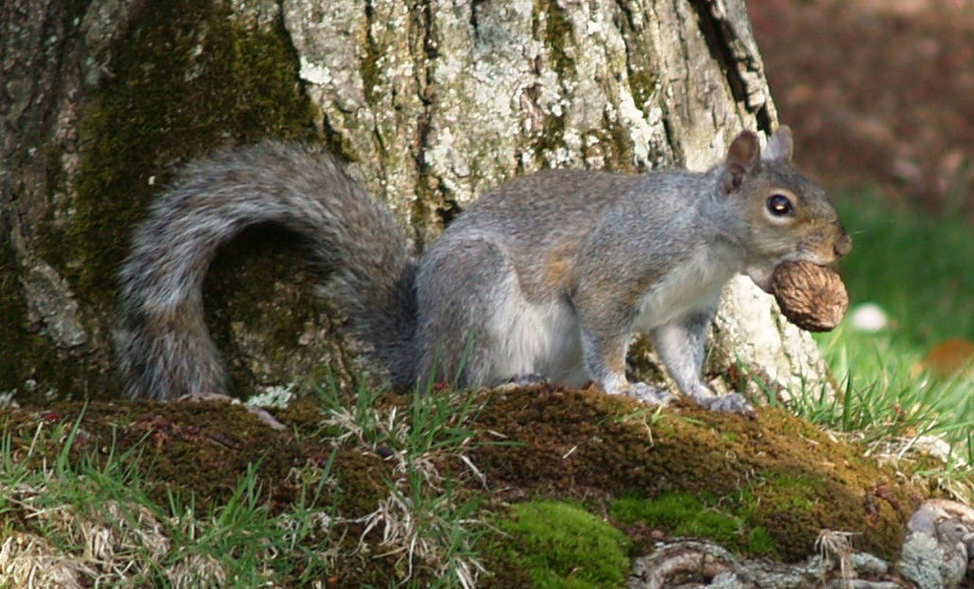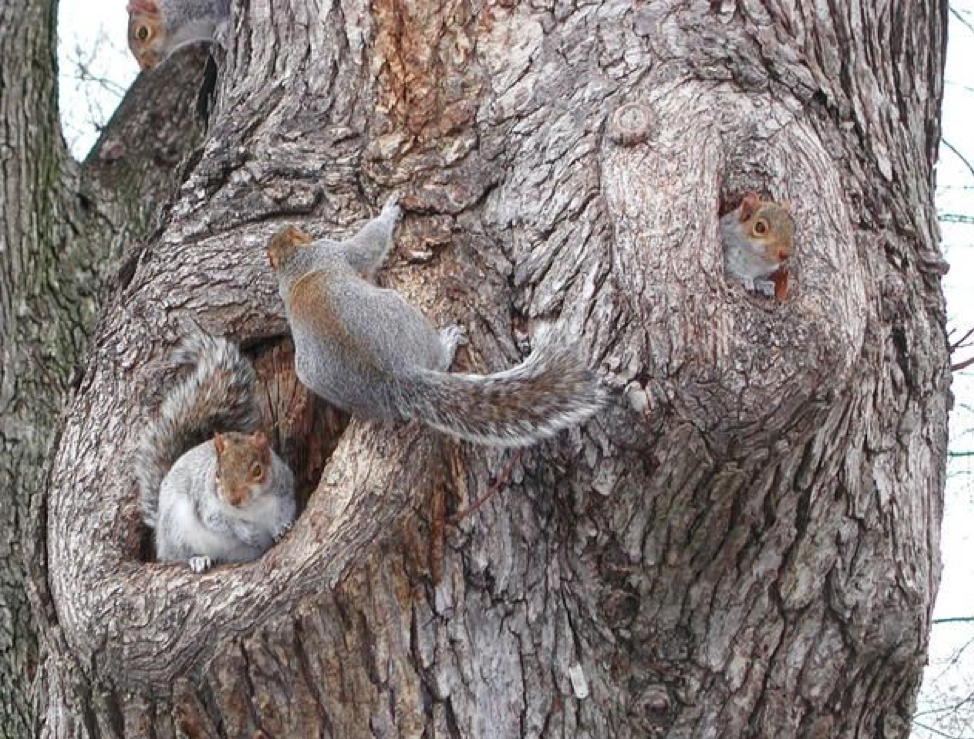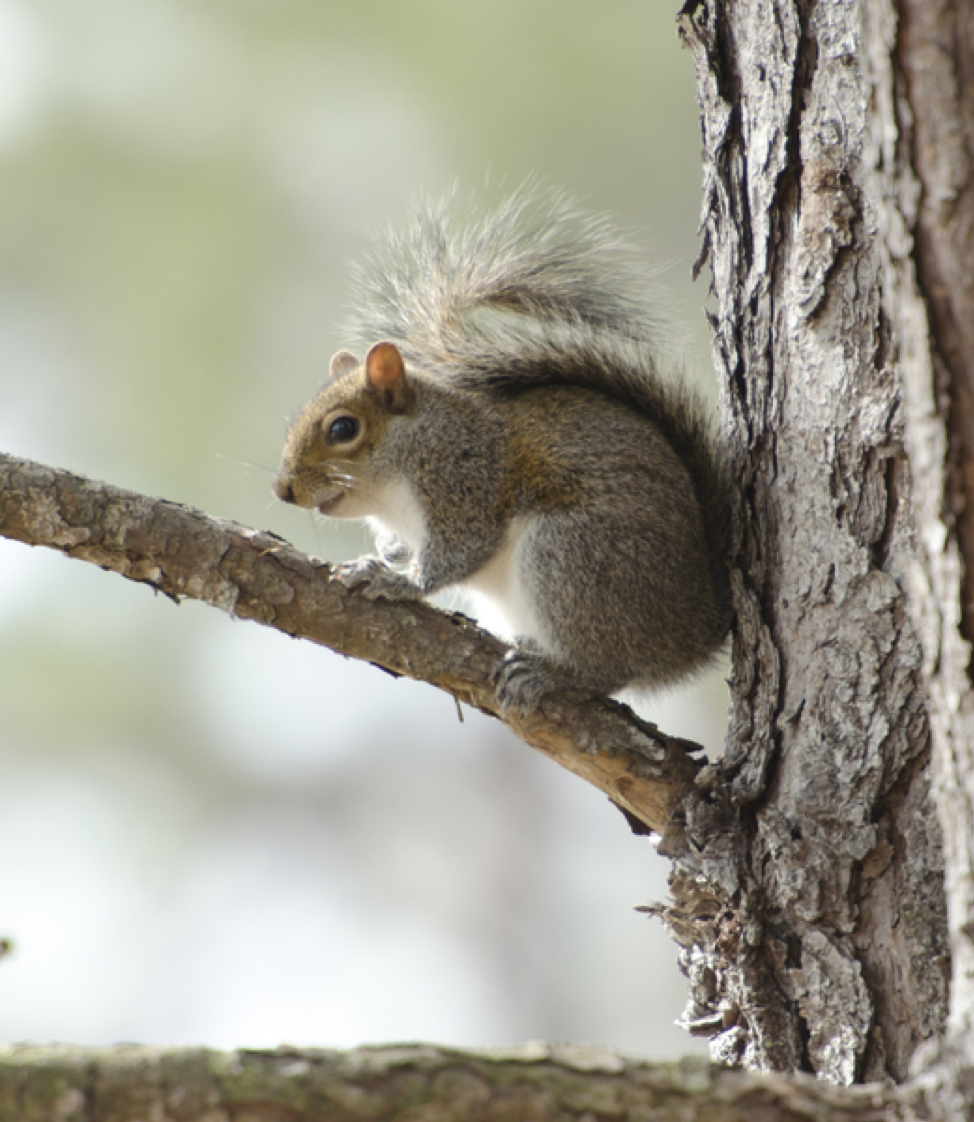eco postcards
eastern Gray Squirrel
This is an Eastern gray squirrel (Sciurus carolinensis). It can be found in Ohio. It is a rodent that can be found dwelling in trees in the eastern part of the United States, north into Canada, and even west of the Mississippi. They frequent places such as parks, woodlands, and places that abundant with nut trees. This species inhabits woodlands that are large with lots of diverse understory vegetation. Populations of this species are highest in forests that food production is high enough to last through winter so that the squirrels have plenty of food for storage. Eastern gray squirrels are small rodents characterized by their medium size, bushy tails and gray bodies. The tail of the Eastern gray squirrel is outlines by tiny, white hairs. Easter grays use their tails for balance as they jump between branches in trees. The color of the squirrel’s body changes seasonally. During winter, the squirrel’s body is gray on top and white underneath. However, in the summer, the squirrel’s body is tannish. Their ears are pale grey to white. Its foreprints are round and approximately 1 inch long; meanwhile, its hindprints are triangular and around 2 and ¼ inches long. Eastern gray squirrels can get up to 20 inches in length and weigh between ¾ to ½ pounds. In the wild, these squirrels typically live up to 12.5 years but can live up to 20 years in captivity.
|
Sciurus carolinensis generally eats nuts, flowers, and buds of 24+ species of oaks, 10+ species of hickory, pecan, walnut, and beech tree species. Other food sources include maple, mulberry, hackberry, elm, bucky, horse chestnut, wild cherry, dogwood, hawthorn, black gum, hazelnut, and ginko tree fruits, seeds, bulbs, and/or flowers. Seeds and catkins of gymnosperms including cedar, hemlock, pine, and spruce are also viable food resources for Eastern Gray squirrels. Corn and wheat are also eaten, generally in winter, while insects are primarily consumed only during summer and usually by juveniles. Other animal foods eaten by this species include bones, bird eggs, and frogs. During the winter these squirrels store their food supply away in bulks called caches. This collection of food is largely done using a method called scatter hoarding. In order to locate these caches, this species uses memory and smell. Squirrels are preyed upon by many different species. Some of these predators include the American mink, weasels, red foxes, bobcats, grey wolves, Canada lynx, coyotes, large birds of prey, and red-tailed hawks. Reproduction amongst Eastern gray squirrels is competitive. The males compete for the chance to mate with the females. Females can mate with more than one male. Copulation generally lasts 30 seconds or less. These squirrels breed twice a year. Breeding season is from December to February and then from May to June but can be slightly delayed in more northern latitudes. Gestation is approximately 44 days long and maturity is reached by females at around 1.25 years and males around 11 months. Females are able to reproduce twice a year for up to 8 years. Newborns are born in litters of 2-4 and without hair and usually weigh 13-18 grams. Adult size and weight are reached by 9 months.
Eastern gray squirrels are most active about 2 hours after sunrise and 2-5 hours before sunset in summer, fall, and spring. This strategy allows them to avoid the hottest parts of the day. During winter, they are unimodally diurnal and their most active time is 2-4 hours before sunset. Females are usually more active in summer months while males are typically more active in the winter. This species generally chooses two different types of homes including a permanent tree den and then a sort of hangout made of leaves and twigs around 30-45 feet above the ground called a crotch. When pregnant, females nest alone and are very aggressive. The home range for an eastern gray squirrel is usually a lot wider in summer than in winter. However, home ranges widen whenever the occupancy of any given area is low and/or when a female is lactating. Various vocalizations and postures are used as means of communication among eastern grays. This includes tail flicking and using their sensitive sense of smell. These means of communication help squirrels to communicate levels of stress and reproductive conditions of each other.
Eastern gray squirrels are important to an ecosystem because they prey on seeds and other animals within their respected ecosystems. The caching of seeds is important to seed dispersal for trees. Additionally, this species acts as hosts for various parasites including ticks, fleas, and roundworms. Predators of eastern grays also depend on them as a food source. Eastern grays are important for humans as well given that they are harvested in some states including Mississippi. About 2.5 million eastern grays are harvested a year equating to an economic impact of nearly 12.5 million dollars. They also have an aesthetic importance to humans in that they are ranked second to birds for nature watchers. Many nature watchers set out feeders for squirrels containing substances such as cracked corn, bird seed, and/or nuts and sunflower seeds. However, squirrels can also have harmful impacts on property when they nest in places such as underneath car hoods and attics. This species is not threatened.
|
CITATIONS
Eastern Gray Squirrel. (n.d.). Retrieved September 21, 2020, from http://naturemappingfoundation.org/natmap/facts/eastern_gray_squirrel_712.html
Image result for eastern grey squirrel nest: Eastern gray squirrel, Squirrel, Baby squirrel. (n.d.). Retrieved September 21, 2020, from https://www.pinterest.com/pin/817333032352845414/
Lawniczak, M. (n.d.). Sciurus carolinensis (eastern gray squirrel). Retrieved September 21, 2020, from https://animaldiversity.org/accounts/Sciurus_carolinensis/
Sciurus carolinensis (eastern gray squirrel). (n.d.). Retrieved September 21, 2020, from https://animaldiversity.org/accounts/Sciurus_carolinensis/pictures/collections/contributors/phil_myers/ADW_mammals/Rodentia/Sciurus8551/
PICTURE CREDITS (TOP TO BOTTOM)
http://naturemappingfoundation.org/natmap/facts/eastern_gray_squirrel_712.html
https://animaldiversity.org/accounts/Sciurus_carolinensis/
https://www.pinterest.com/pin/817333032352845414/
https://animaldiversity.org/accounts/Sciurus_carolinensis/pictures/collections/contributors/phil_myers/ADW_mammals/Rodentia/Sciurus8551/
Eastern Gray Squirrel. (n.d.). Retrieved September 21, 2020, from http://naturemappingfoundation.org/natmap/facts/eastern_gray_squirrel_712.html
Image result for eastern grey squirrel nest: Eastern gray squirrel, Squirrel, Baby squirrel. (n.d.). Retrieved September 21, 2020, from https://www.pinterest.com/pin/817333032352845414/
Lawniczak, M. (n.d.). Sciurus carolinensis (eastern gray squirrel). Retrieved September 21, 2020, from https://animaldiversity.org/accounts/Sciurus_carolinensis/
Sciurus carolinensis (eastern gray squirrel). (n.d.). Retrieved September 21, 2020, from https://animaldiversity.org/accounts/Sciurus_carolinensis/pictures/collections/contributors/phil_myers/ADW_mammals/Rodentia/Sciurus8551/
PICTURE CREDITS (TOP TO BOTTOM)
http://naturemappingfoundation.org/natmap/facts/eastern_gray_squirrel_712.html
https://animaldiversity.org/accounts/Sciurus_carolinensis/
https://www.pinterest.com/pin/817333032352845414/
https://animaldiversity.org/accounts/Sciurus_carolinensis/pictures/collections/contributors/phil_myers/ADW_mammals/Rodentia/Sciurus8551/




